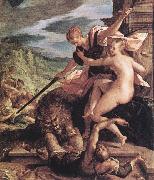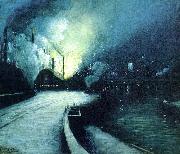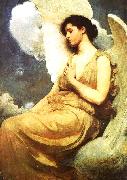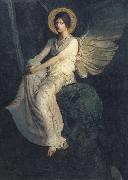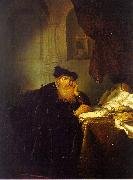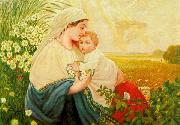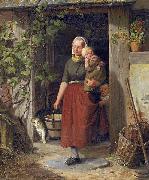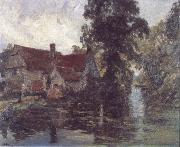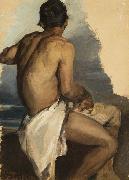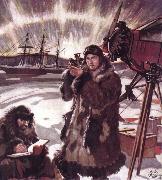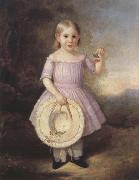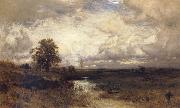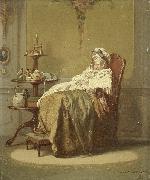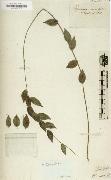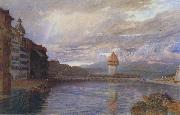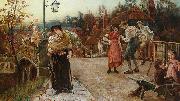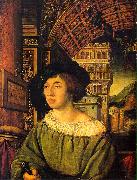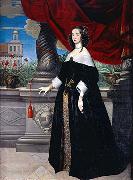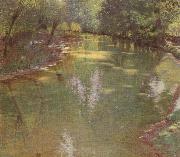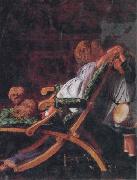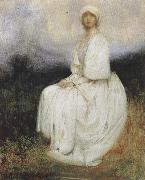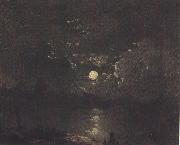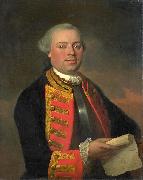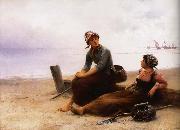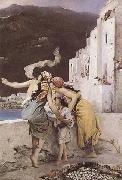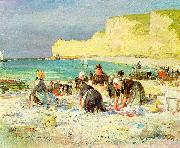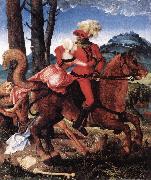|
|
|
|
|
|
|
|
|
|
|
|
|
|
|
|
|
|
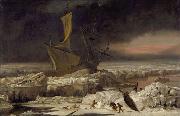 |
Abraham Hondius
|
|
(1625 - 1691) was a Dutch Golden Age painter known his depictions of animals. He was the son of a city stonemason, Daniel Abramsz de Hondt.
Hondius was born in Rotterdam and trained under Pieter de Bloot ( 1601 - 1658) and Cornelis Saftleven.He lived in Rotterdam until 1659 and moved then to Amsterdam. He moved to London] in 1666, where he spent the rest of his life. Hondius combined throughout his career several stylistic influences and struggled to develop a style of his own. He however specialised somehow in animal pieces: more than two-thirds of his paintings, etchings and drawings are hunting scenes, animals fighting and animal studies. He also executed landscapes, genre and religious scenes.
Hondius most likely moved to London] (where he later died) in 1666 where he spent the rest of his life. He painted views of London such as The Frost Fair on the Thames at Temple Stairs and London Bridge. His last known work is "Ape and Cat Fighting over Dead Poultry," dated 1690.
|
|
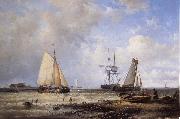 |
Abraham Hulk
|
|
1813-1897 Born in London, the senior member and best known of a family of painters, Abraham Hulk studied in Holland at the Amsterdam Academy under portrait painter Jean Augustin Daiwaille. |
|
|
|
|
|
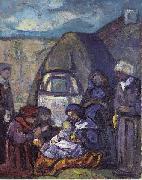 |
Adolf Holzel
|
|
(13 May 1853 - 17 October 1934) was a German artist/painter. His style developed from Impressionism to expressive modernism.
He was born in Olomouc in Moravia, the son of the publisher Eduard Hölzel. In 1871 his family moved to Vienna, and from 1872 he studied painting at the Vienna Academy. He continued his studies in Munich at the Kunstakademie beginning in 1876. There he became acquainted with the painter Fritz von Uhde and painted in a style influenced by Impressionism.
From 1888 to 1905 he worked in Dachau, where there was an artists' colony. Already during his time in Dachau his work began moving toward abstraction, reflecting his interest in such principles as the golden section and Goethe's Theory of Colors. He taught at the Stuttgart Academy, and paintedefour years before Wassily Kandinskyean abstract painting (Composition in Red, 1905). Among his students the so-called "Hölzel circle" developed, including Oskar Schlemmer, Willi Baumeister, Max Ackermann and Johannes Itten. In 1919 Adolf Hölzel left the Stuttgart Academy and went into retirement. He died in Stuttgart in 1934.
|
|
|
|
|
|
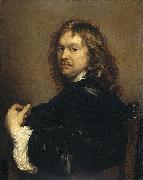 |
Adriaen Hanneman
|
|
(c. 1603 - buried 11 July 1671) was a Dutch Golden Age painter best-known today for his portraits of the exiled British royal court. His style was strongly influenced by his contemporary, Anthony Van Dyck.
|
|
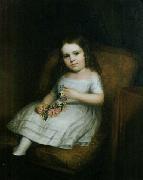 |
Albert Gallatin Hoit
|
|
Albert Gallatin Hoit (December 13, 1809 - December 18, 1856) was an American painter who lived in Boston, Massachusetts. He painted portraits of William Henry Harrison, Daniel Webster and Brenton Halliburton.
Hoit was born in Sandwich, New Hampshire, December 13, 1809, to Gen. Daniel Hoit and Sally Flanders. Siblings included William Henry Hoit. Hoit graduated from Dartmouth College in 1829. He married Susan Hanson in 1838; children included Anna M. Hoit.
Hoit "devoted his life to portrait painting, first at Portland, Maine, in 1831, and then in Bangor and Belfast, Maine, and St. John's, N.B. until Boston, Mass., became his permanent home in 1839." He also travelled in Europe, "Oct. 1842 to July 1844, ... enjoying the galleries of art in Italy, Paris, and London." He created portraits of Pietro Bachi, Johanna Robinson Hazen, J. Eames, and others. He painted a portrait of Daniel Webster "for Paran Stevens, which hung for years in the Revere House, Boston, and now belongs to the Union League Club, New York."
He was affiliated with the Boston Artists' Association; and exhibited at the gallery of the New England Art Union in the 1850s. In 1848, he kept a studio on Tremont Row in Boston, and lived in Roxbury. By 1852, he'd moved his studio to Washington Street.
Hoit died in Jamaica Plain, December 18, 1856, at age 47.
|
|
|
|
|
|
|
|
|
|
|
|
|
|
|
|
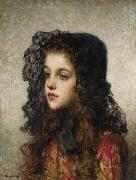 |
Alexei Harlamov
|
|
(or Alexej Harlamoff - Alexej Charlamoff) (1840-1925) was a Russian painter.
Harlamoff paintings are signed "Harlamoff", which may be a translation he learned while studying in Paris. This does not translate into the Russian language from English. |
|
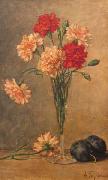 |
Alfred Hirv
|
|
(born March 26, 1880 in Pechory - died May 26, 1918 in Pskov) was an Estonian painter, known especially for his still lifes. For a time he studied with Julius von Klever in Saint Petersburg; further studies took him to Rome and Munich, where he studied at the school of Anton Ažbe. His paintings are reminiscent of the style of the Dutch Golden Age. Works by Hirv can be found in the Estonian Art Museum.
|
|
|
|
|
|
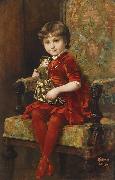 |
Alois Hans Schram
|
|
Alois Hans Schram
(1864 - 1919)
Alois Hans Schram was born in Vienna on August 20th. He was a painter and sculptor of historical subjects, figures, nudes, portraits, scenes with figures, genre scenes, local scenes, interiors with figures, landscapes with figures, urban landscapes, waterscapes and seascapes. |
|
|
|
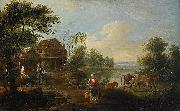 |
Anders Holm
|
|
(1751 -1824 ) - Painter
is a comedy writer and one of the stars and creators of the Comedy Central show Workaholics. Originally from Evanston, Illinois, Holm graduated from the University of Wisconsin - Madison and the Second City Conservatory in L.A. He, along with fellow Workaholics creators Blake Anderson, Adam DeVine and Kyle Newacheck form the sketch-comedy group, Mail Order Comedy. He also starred in a film, the Legend of Awesomest Maximus.
|
|
|
|
|
|
|
|
 |
Anton Hickel
|
|
(1745 - October 30, 1798) was an 18th-century painter.
Hickel was born in Český Krumlov, Bohemia, and enrolled in the Academy of Fine Arts Vienna in Vienna, Austria in 1758. After graduation, he worked as a painter under his brother, Joseph Hickel, who was also a painter. Beginning in 1779, he served as a traveling portrait painter. He spent considerable time in Munich where he painted Charles Theodore, Elector of Bavaria, among others. He then traveled in southern Germany, Switzerland, then to Mannheim and Mainz. He moved to Switzerland in 1785, and then became the official court painter of Joseph II, Holy Roman Emperor. In 1786, he travelled to France where he painted under the patronage of Marie Antoinette and Marie-Louise, princesse de Lamballe. He died in Hamburg.
|
|
|
|
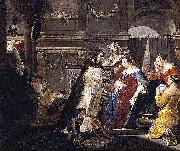 |
Arnold Houbraken
|
|
(28 March 1660 - 14 October 1719) was a Dutch painter and writer from Dordrecht, now remembered mainly as a biographer of artists from the Dutch Golden Age. He had ten children. His son Jacobus Houbraken (1698-1780) was an engraver of portraits and book illustrations, including books by his father. His daughter Antonina Houbraken also became an engraver for an Amsterdam publisher, and is known today for her embellishment of cityscapes and buildings with animals and people.
Houbraken was sent first to learn threadtwisting from Johannes de Haan, who introduced him to engraving. After two years he then studied art with Willem van Drielenburch, who he was with during the rampjaar, the year 1672. He then studied 9 months with Jacobus Leveck and finally, four years with Samuel van Hoogstraten. In 1685 he married Sara Sasbout, and around 1709 he moved from Dordrecht to Amsterdam. Arnold Houbraken painted mythological and religious paintings, portraits and landscapes. |
|
|
|
|
|
|
|
|
|
|
|
|
|
|
|
|
|
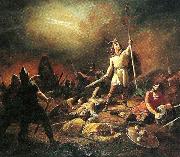 |
axel gustaf hertzberg
|
|
1832-1878
Axel Gustaf Hertzberg född 27 augusti 1832 i Jämtland, död 2 september 1878 i Dusseldorf , Tyskland var en svensk bildkonstnär.
Hertzberg ägnade sig först åt porträtteckning och litografi men övergick senare till oljemåleri. Han studerade vid konstakademien i Stockholm 1849-1860. Han gjorde en resa till Finland där han stannade två år. Därefter studerade han konst i Paris, och slutligen Dusseldorf.
Hertzberg blev 1867 agre vid konstakdemien i Stockholm. |
|
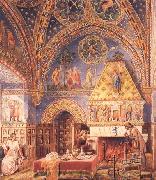 |
Axel Haig
|
|
Swedish etcher and architectural draughtsman , 1835-1921 |
|
|
|
|
|
|
|










